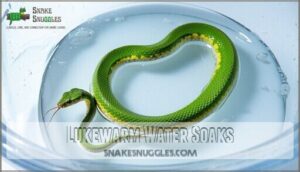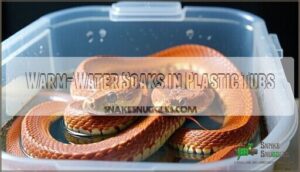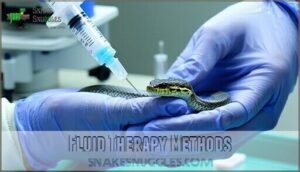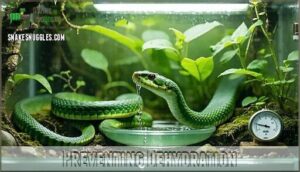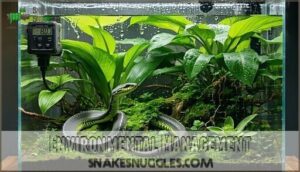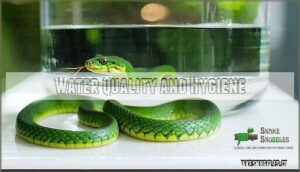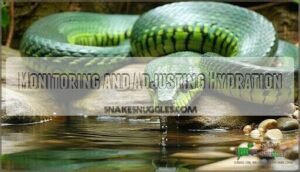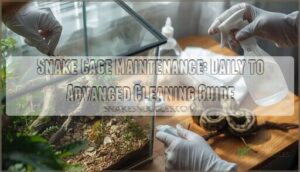This site is supported by our readers. We may earn a commission, at no cost to you, if you purchase through links.
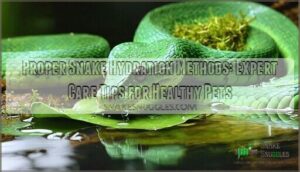 Proper snake hydration methods depend on your species’ natural habitat needs.
Proper snake hydration methods depend on your species’ natural habitat needs.
You’ll maintain 60-80% humidity for tropical snakes through daily misting and large water bowls, while desert species thrive at 30-50% humidity with occasional misting.
Change water daily, position bowls near warm areas, and create humid hides using damp moss or paper towels.
Monitor for dehydration signs like sunken eyes, wrinkled skin, or sticky saliva.
Use lukewarm water for soaking sessions lasting 10-15 minutes to help with shedding and rehydration.
Quality matters too—filtered or bottled spring water prevents mineral buildup and bacterial growth that could harm your snake’s health, ensuring a safe environment with proper hydration.
Table Of Contents
Key Takeaways
- Monitor humidity levels closely – You’ll need to maintain 60-80% humidity for tropical species and 30-50% for desert snakes, using daily misting and proper substrates to prevent dehydration.
- Recognize dehydration signs early – Watch for sunken eyes, wrinkled skin, sticky saliva, and shedding problems, as these symptoms indicate your snake needs immediate rehydration.
- Provide proper water sources – You should offer fresh, filtered water daily in appropriately sized bowls and create humid hides using damp moss for optimal hydration.
- Use lukewarm water soaks – When dehydration occurs, you’ll need to soak your snake in 80-85°F water for 15-30 minutes to help with rehydration and shedding issues.
Recognizing Dehydration
You’ll spot dehydration in your snake by watching for several key physical signs that indicate your pet needs immediate attention.
The most obvious symptoms include sunken eyes, wrinkled skin, lethargy, sticky saliva, and problems with shedding that signal your snake’s body is struggling to maintain proper fluid levels.
These symptoms, such as lethargy, are critical indicators that your snake requires prompt care to prevent further health complications.
Sunken Eyes and Wrinkled Skin
The most obvious dehydration signs appear when your snake’s condition becomes serious—sunken eyes and wrinkled skin signal severe dehydration requiring immediate action.
These symptoms indicate your pet needs urgent rehydration and veterinary consultation to prevent further complications.
Key severity assessment indicators:
- Sunken eyes – Eyes appear recessed into the skull, indicating significant fluid loss
- Wrinkled skin – Skin loses elasticity and forms visible folds, especially around the neck
- Immediate actions needed – Begin rehydration urgency protocols and contact your veterinarian immediately
Lethargy and Weakness
When dehydration sets in, your snake’s energy levels plummet dramatically.
When dehydration hits, your snake becomes sluggish and weak, unable to function normally.
You’ll notice reduced appetite and behavioral changes as their body struggles with muscle function and temperature regulation.
Digestive issues often follow, creating a cascade of health problems.
Watch for these lethargy symptoms during routine hydration monitoring – they’re early warning signs that shouldn’t be ignored, serving as a critical indicator of your snake’s overall well-being.
Sticky or Dry Saliva
During an oral examination, you’ll notice that dehydrated snakes produce sticky or dry saliva with increased viscosity.
This thickened consistency makes their mouth tissues and mucous membranes feel tacky to the touch.
The saliva’s texture becomes more pronounced as dehydration severity worsens, creating a telltale sign that’s easily detected during routine health checks.
Retained Shed or Difficulty Shedding
When your snake struggles with shedding, it’s often your first clue that dehydration is setting in.
A struggling shed is your snake’s cry for help—hydration trouble ahead.
Poor skin elasticity and difficulty removing old skin signal that humidity levels aren’t meeting your pet’s needs, creating a cycle where retained shed worsens dehydration symptoms.
Here are five key indicators of shedding-related dehydration:
- Patchy shed remnants – Pieces of old skin stick to eyes, tail tips, or between scales
- Increased shedding frequency – Your snake attempts to shed more often than normal cycles
- Dull, tight-looking skin – Loss of natural flexibility and healthy appearance
- Scale damage – Cracked or split scales from forced shedding attempts
- Extended shedding environment needs – Snake spends excessive time in humid hides or water bowls
The nutritional impact of dehydration affects your snake’s ability to produce the oils needed for smooth shedding.
When proper humidity isn’t maintained, their skin loses elasticity, making the natural shedding process nearly impossible.
This creates a dangerous cycle where poor snake hydration leads to retained shed, which then blocks normal moisture absorption through the skin.
Hydration Warning Signs
Beyond the initial warning bells, you’ll notice your snake’s behavior and physical condition shifting in subtle but telling ways.
Skin wrinkling becomes more pronounced, creating loose folds that don’t snap back quickly when gently pinched.
Eye sinking progresses from slightly recessed to deeply sunken, giving your pet a hollow, unwell appearance.
Shedding issues emerge as incomplete or patchy skin removal, with stubborn pieces clinging to the body for days.
Lethargy signs manifest as decreased movement, reluctance to explore, and extended periods of inactivity.
Saliva viscosity increases dramatically, becoming thick and sticky during routine mouth checks.
These dehydration symptoms collectively paint a clear picture of declining health.
Watch for wrinkled skin that stays tented, sunken eyes that appear dull, and persistent lethargy that affects normal behaviors.
Recognizing these dehydration signs early prevents serious complications and guarantees your snake’s wellbeing.
Rehydration Strategies
When your snake shows signs of dehydration, you’ll need to act quickly with proven rehydration methods.
These techniques range from simple environmental adjustments to more advanced interventions that can restore your pet’s health effectively.
Increasing Humidity Through Misting
Regularly misting your snake’s enclosure creates the humid microclimate essential for proper hydration.
Adjust misting frequency based on species needs—tropical snakes require daily applications while desert species need less frequent sessions.
Use fine-mist nozzles for even coverage and consider automation systems for consistent humidity levels.
A reptile misting system can guarantee consistent humidity.
Monitor water source quality and tailor misting techniques to your snake’s natural habitat requirements to ensure proper hydration and a suitable environment.
Providing Humid Hides and Water Bowls
Creating safe spaces for your snake starts with strategic placement.
Position humid hides on the warm side of your snake enclosure, using materials like damp sphagnum moss or paper towels.
Water bowls should be large enough for soaking but shallow enough to prevent drowning.
Consider buying a snake hide to help maintain proper humidity.
Clean bowls every 2-3 days to maintain proper humidity levels and prevent bacterial growth, adjusting based on species needs.
Oral Rehydration With Electrolyte Solutions
When dealing with moderate dehydration, electrolyte solutions offer targeted rehydration methods beyond plain water.
You’ll need proper solution dilution—typically 75% sports drink mixed with 25% water—for safe oral administration. Calculate dosage carefully, never exceeding 2% of your snake’s body weight per session.
Use a needle-free syringe for controlled delivery, ensuring your snake remains alert throughout. Always seek veterinary supervision for severe cases or when determining appropriate administration methods for your specific species.
Sunken eyes in snakes can be a key indicator of dehydration signs.
Subcutaneous Fluids Administration
When oral rehydration isn’t enough, subcutaneous fluids offer targeted treatment for moderate dehydration.
This veterinary-supervised technique delivers isotonic solutions directly under the skin, bypassing digestive absorption issues. Think of it as giving your snake an IV drip without the complexity.
Reptiles benefit from fluids like Lactated Ringers, but fluid choices matter based on lab work.
Key administration points:
- Injection sites: Target the lateral body wall midway up the snake’s side, avoiding the lower half to protect kidney function
- Dosage calculation: Administer 20-25 mL/kg every 1-2 days for mild dehydration, using pre-warmed isotonic fluids like Lactated Ringer’s
- Veterinary oversight: Professional supervision guarantees proper technique and monitors for complications like overhydration or infection risks
Soaking Techniques
When your snake shows signs of dehydration, proper soaking techniques can make the difference between a quick recovery and a serious health crisis.
These methods work by allowing your snake to absorb water through its skin and encouraging natural drinking behaviors that help restore essential fluid levels.
Lukewarm Water Soaks
Water soaks work wonders for dehydrated snakes when done correctly.
Fill a plastic tub with lukewarm water at 80-85°F, ensuring the water depth reaches halfway up your snake’s body.
Soak for 15-30 minutes, monitoring temperature control throughout.
Choose smooth tub material to prevent injuries, as this soaking technique provides gentle rehydration methods while maintaining snake safety during the warm-water soak process.
Misting and Rain Chambers
Misting and rain chambers offer targeted hydration for arboreal species that naturally drink water droplets.
These systems work particularly well for species like green tree pythons and emerald tree boas. A digital hygrometer guarantees accurate humidity monitoring.
- Automated Misting: Install timer-controlled systems with adjustable nozzle types for consistent moisture delivery
- DIY Chambers: Create simple setups using spray bottles or drip systems for budget-friendly reptile misting
- System Maintenance: Clean nozzles weekly and monitor humidity levels to prevent bacterial growth in chambers
Warm-Water Soaks in Plastic Tubs
A proper setup makes all the difference when soaking your snake.
Use a plastic tub that’s large enough for your snake to move comfortably but not so spacious they’ll feel exposed.
Fill it with lukewarm water at 80-85°F—test with your elbow like you’d a baby’s bath.
Soak for 15-30 minutes, creating a secure lid with air holes for snake safety.
Consider using a suitable snake enclosure for soaking.
Clean and disinfect tubs after each use to prevent bacterial growth and ensure a safe environment.
Fluid Therapy Methods
When home remedies aren’t enough, you’ll need to escalate to more intensive fluid therapy methods that can save your dehydrated snake’s life.
These medical-grade techniques range from gentle water baths to veterinary-administered parenteral fluids, each designed to restore proper hydration levels based on your snake’s specific condition, utilizing medical-grade techniques.
Water Baths and Oral Fluids
Beyond soaking snake techniques, you’ll need targeted fluid therapy for severe dehydration.
Water baths three times daily help rehydrate snake effectively when maintained at proper Bath Temperature (80-84°F), and Bath Duration should last 15-30 minutes, allowing gradual fluid absorption.
Remember that frequent bathing risks dehydration and stress.
For oral rehydration, use pipette feeding with diluted electrolyte solutions to maintain Electrolyte Balance, and avoid Fluid Aspiration by controlling Oral Dosage carefully during lukewarm water bath sessions, ensuring proper oral rehydration.
Parenteral Fluids Administration
When basic soaking methods aren’t enough, you’ll need parenteral fluids—medication delivered directly into your snake’s body.
Veterinary supervision is essential for subcutaneous fluids, injected under the skin at specific sites like the lateral body wall.
Proper fluid types include diluted electrolyte solutions matched to reptilian plasma.
Dosage calculation depends on dehydration severity, while aseptic technique prevents infection.
Potential complications include tissue damage if administered incorrectly.
Electrolyte Solutions and Ratios
Commercial electrolyte solutions like Zoo Med Reptile Electrolyte Soak contain balanced sodium, potassium, and vitamins for safe hydration.
DIY electrolytes using 3:1 sports drink ratios work effectively but require precise measurements.
Commercial formulas match reptile plasma osmolarity (273-295 mOsm/L), preventing metabolic imbalances.
Always consult your reptile veterinarian for proper bath concentrations and dosages, especially with severe dehydration signs.
Preventing Dehydration
Prevention isn’t just about fixing problems after they start—it’s about creating an environment where dehydration never becomes an issue in the first place.
By maintaining proper humidity levels, providing fresh water daily, and conducting regular health checks, you’ll keep your snake healthy and hydrated throughout its life.
Maintaining Proper Humidity Levels
Maintaining proper humidity levels creates the foundation for preventing dehydration in your snake.
You’ll need consistent humidity monitoring and control systems to keep your pet healthy.
Here’s your essential humidity management checklist:
- Monitor humidity levels using digital hygrometers placed at different enclosure heights
- Adjust substrate choice to moisture-retentive options like cypress mulch or coconut husk
- Create humidity gradients with different moisture zones throughout the habitat
- Ensure proper ventilation to prevent stagnant air while maintaining humidity
- Make seasonal adjustments for winter heating and summer evaporation changes
Providing Fresh and Clean Water
Fresh water serves as your snake’s lifeline, requiring daily attention to prevent dehydration-related health issues.
Choose dechlorinated water or bottled spring water over tap water when possible. Water bowl size should accommodate your snake’s body width comfortably, allowing natural drinking behaviors while preventing drowning risks.
| Water Management | Recommended Practice |
|---|---|
| Water bowl placement | Away from heat sources, stable surface |
| Cleaning frequency | Daily rinse, weekly deep clean |
| Water source type | Filtered, bottled spring, or treated tap |
| Multiple water bowls | Consider for larger enclosures |
Monitor water quality closely—cloudy or contaminated water harbors bacteria that compromise your pet’s health.
Regular Health Checks and Balanced Diet
Vigilant observation forms the foundation of effective snake hydration, as your pet’s overall wellness directly impacts their ability to maintain proper fluid balance.
Regular monitoring helps you catch dehydration signs early and adjust care accordingly.
- Weight Monitoring: Track your snake’s weight weekly to identify gradual dehydration before visible symptoms appear
- Shedding Frequency: Monitor shed cycles closely, as irregular or incomplete shedding often indicates hydration issues requiring dietary adjustments
- Fecal Analysis: Examine waste consistency and frequency, since proper hydration supports healthy digestion and supplementation needs
Environmental Management
Creating the right environment for your snake’s hydration needs requires careful attention to air circulation, humidity zones, and monitoring equipment.
You’ll need to balance proper ventilation with moisture retention while using reliable tools to track and adjust conditions as needed, which is crucial for maintaining the right humidity levels.
Ensuring Proper Enclosure Ventilation
Proper airflow prevents stagnant air that breeds harmful bacteria and mold in your snake’s enclosure.
Install ventilation holes near the top and bottom to create natural air circulation without creating drafts.
Screen lids provide excellent ventilation while maintaining security.
Cross-ventilation through multiple ventilation points guarantees fresh air reaches all areas.
Remember, good airflow doesn’t mean wind tunnels—gentle circulation works best, and it’s essential to avoid creating wind tunnels while ensuring fresh air reaches all areas.
Creating Humidity Gradients and Microclimates
Beyond proper ventilation, you’ll want to create distinct enclosure zones that mimic your snake’s natural habitat.
Different humidity levels throughout the enclosure support natural behaviors and meet species needs.
Gradient Benefits and Practical Application:
- Warm side: Lower humidity (40-50%) for basking and digestion
- Cool side: Higher humidity (60-70%) with humid hides for comfort
- Misting enclosure: Target specific areas rather than the entire space
- Substrate variation: Use different materials to create natural microclimates
- Hide placement: Position humid hides in cooler zones for ideal comfort
This setup lets your snake choose its preferred humidity levels naturally.
Using Hygrometers and Humidifiers
Accurate hygrometer calibration guarantees reliable humidity level monitoring in your snake’s enclosure.
Digital hygrometers offer precise readings, while analog versions need regular checking.
Ultrasonic humidifiers provide consistent moisture without heat, creating stable humidity zones.
Automated systems with timers maintain ideal conditions while you’re away.
Natural substrates aid in moisture retention and humidity control.
Check humidity levels daily, adjusting humidifiers as needed for proper humidity control.
Species-Specific Hydration
Different snake species have vastly different hydration requirements that mirror their natural habitats.
You’ll need to adjust your approach whether you’re caring for a humidity-loving ball python or a desert-dwelling sand boa, as each species has evolved specific water needs that directly impact their health and shedding success.
Tropical Snakes and High Humidity
Tropical species need humidity levels between 70-90% for ideal health.
Rainbow boas and emerald tree boas are particularly sensitive to low humidity, which causes shedding problems and kidney issues.
Use daily misting and rain chambers to maintain proper moisture levels.
Arboreal snakes often prefer drinking water droplets from misting rather than standing water bowls.
Desert Species and Low Humidity
Desert dwellers like Western hognose snakes have evolved remarkable arid adaptations for water conservation.
These species thrive in 30-50% humidity, far lower than their tropical cousins.
Their specialized substrate choice and nocturnal behavior minimize water loss, while strategic basking behavior helps regulate hydration.
Desert species demonstrate that proper hydration methods must respect their natural water conservation strategies.
Boas and Pythons and Stable Water Bowls
Both boas and pythons thrive when you provide stable water bowls that meet their specific needs.
Choose bowl material that’s easy to clean and won’t tip over when your snake soaks. Water depth should allow full submersion while maintaining snake behavior patterns.
Bowl size matters – make certain it’s large enough for soaking but not overwhelming.
Clean weekly to prevent bacterial growth and maintain proper snake hydration.
Water Quality and Hygiene
Clean water isn’t just nice to have—it’s essential for your snake’s health and can make the difference between successful rehydration and introducing harmful bacteria.
You’ll want to establish a consistent cleaning routine that keeps both water sources and soaking equipment safe and sanitary.
Using Filtered or Bottled Spring Water
Your snake’s water source plays a pivotal role in maintaining ideal hydration and preventing health issues.
Choose filtered or bottled spring water over tap water to eliminate chlorine, chloramine, and heavy metals that can harm your pet.
Spring water retains essential minerals for proper physiological function, while distilled water lacks these essential nutrients.
This simple switch supports better snake hydration and reduces water quality concerns, ultimately leading to a healthier pet with proper hydration.
Cleaning Water Bowls and Soaking Tubs
Through proper maintenance, you’ll keep your snake’s water source crystal clear and bacteria-free.
Clean water bowls every 2-3 days using reptile-safe disinfectants, scrubbing away stubborn biofilm with a dedicated brush.
Choose non-porous tub material like glass or ceramic for easier cleaning, and regular scrubbing frequency prevents harmful bacteria buildup, ensuring ideal snake hydration and water quality for your reptile’s health.
Monitoring and Adjusting Hydration
You’ll need to establish a consistent monitoring routine to catch dehydration early and maintain your snake’s health.
Regular visual inspections combined with proper water maintenance create the foundation for effective hydration management, which is crucial for your snake’s overall well-being, and this can be achieved through proper care.
Weekly Hydration Monitoring Schedule
Consistently tracking your snake’s hydration prevents serious health issues through systematic monitoring. Create weekly hydration logs documenting visual inspections, weight tracking, and behavior changes.
Record shedding frequency and note any handling checks during shedding periods. Monitor dehydration check frequency, adjusting based on seasonal changes and your snake’s specific needs for ideal hydration monitoring.
Remember that environmental humidity impacts proper shedding. This is crucial for maintaining your snake’s overall health, ensuring ideal hydration monitoring and preventing dehydration, which can be achieved through consistent tracking.
Visual Checks and Water Bowl Maintenance
Regular visual cues reveal your snake’s hydration status through skin elasticity and eye appearance.
Check water freshness daily, replacing stagnant water that attracts bacteria.
Bowl sanitation requires scrubbing every 2-3 days with reptile-safe disinfectants.
Refilling frequency depends on evaporation rates and your snake’s soaking access preferences, ensuring consistent fresh water availability for ideal snake hydration and health, with a focus on fresh water.
Addressing Mild Dehydration and Seeking Veterinary Care
When home interventions like lukewarm water soaks and increased humidity don’t resolve dehydration within 24-48 hours, it’s time to escalate your approach.
Persistent symptoms or worsening dehydration severity require veterinary expertise immediately.
- Apply rehydration techniques like electrolyte soaks before clinical dehydration develops
- Monitor for improvement within two days of starting hydration monitoring
- Contact your reptile veterinarian if symptoms persist despite preventative measures
- Seek immediate veterinary care for severe cases requiring subcutaneous fluids
Frequently Asked Questions (FAQs)
How to hydrate your snake?
You’ll need to provide lukewarm water soaks for 15-30 minutes, maintain proper humidity levels around 50-70%, and make certain fresh water’s always available in shallow bowls for drinking.
How do I tell if my snake is dehydrated?
Watch your snake’s eyes and skin like a weather vane signals change.
Sunken eyes, wrinkled skin, and sticky saliva reveal dehydration’s grip.
Check for retained shed patches and decreased activity levels.
Can snakes drink from moving water sources?
Yes, snakes can drink from moving water sources like streams or waterfalls.
Many species naturally drink from flowing water in the wild, and some actually prefer it over still water since it’s typically fresher and cleaner.
How often should I change substrate for humidity?
While weekly substrate changes seem excessive, you’ll actually need to replace moisture-retentive substrates like cypress mulch every 2-3 weeks for ideal humidity retention and cleanliness.
Do baby snakes need different hydration methods?
Baby snakes require more frequent hydration monitoring and smaller water sources. You’ll need shallower bowls, higher humidity levels, and gentler soaking methods since their smaller bodies dehydrate faster than adults.
Which water temperature is safest for soaking?
Studies show that 84-87°F water temperature provides ideal absorption rates for dehydrated snakes.
You’ll want to keep soaking sessions between 15-30 minutes at this temperature range, which feels comfortably warm to your touch.
Can overhydration harm my snakes health?
Overhydration rarely occurs in snakes, but prolonged soaking can cause stress, respiratory issues, and skin problems. You shouldn’t worry about it with normal hydration methods.
Conclusion
Picture your snake’s scales glistening with perfect hydration—a sign of excellent care and attention to detail.
Mastering proper snake hydration methods guarantees your pet’s long-term health and vitality. You’ll need to monitor humidity levels, provide clean water daily, and recognize dehydration signs early.
Remember that different species require specific hydration approaches, from tropical snakes needing 60-80% humidity to desert species thriving at 30-50%.
With consistent environmental management and quality water sources, you’ll maintain your snake’s prime health for years to come, ensuring proper snake hydration and long-term health.
- https://www.dvm360.com/view/fluid-therapy-reptiles-proceedings
- https://ncseagrant.ncsu.edu/hooklinescience/do-water-snakes-get-thirsty/
- https://www.nationalgeographic.com/animals/article/thirsty-animals-stay-hydrated-using-these-ingenious-techniques
- https://www.lllreptile.com/articles/110-water-and-hydration-for-herps/
- https://www.ingleside.com/services/other-pets/blog/how-bathe-your-reptile


